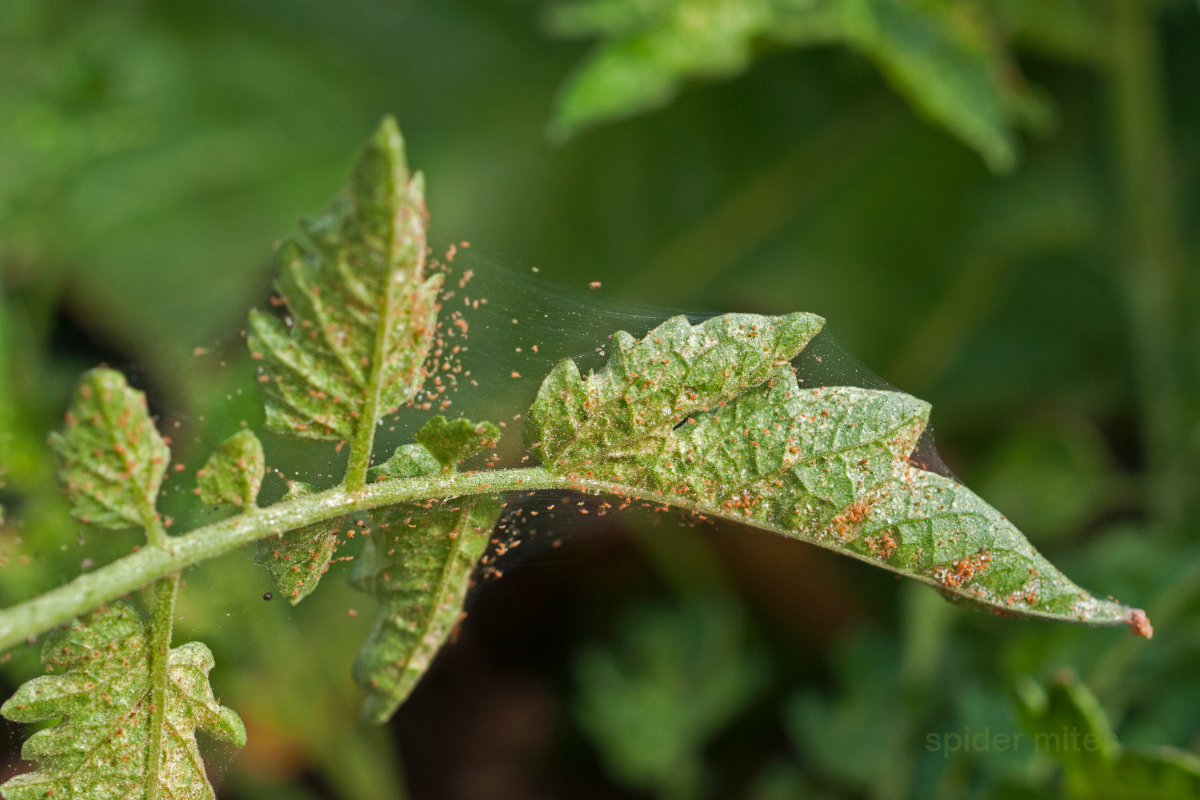
Natural Spider Mite Prevention: Chemical-Free Solutions to Protect Your Plants
Few things are more disappointing to growers than recognizing a disease is affecting your plants. Spider mites are a common threat to many vegetables, vines, berries, and fruit trees, as well as numerous annual and perennial ornamental plants. You are very likely to encounter these garden pests due to the wide range of plants on which they feed.
Multiple species of spider mites exist. Pacific spider mites, two-spotted spider mites, broad mites, russet mites, clover mites, maple spider mites, and over 1000 more, seek out host plants to infect, with results ranging from a mild aesthetic impact to a total crop loss that can financially devastate a grower whose garden provides food and income.
These mites feed on foliage. They have piercing mouthparts that puncture a leaf before they suck up the contents of its leaking cells and empty the leaf of any nutrition. As the foliage quality declines, they find a new target.
Managing spider mites is challenging, partly due to their ability to spread. They hide among plants, weeds, cracks in the earth, and within purchased plant material like soil and mulch, waiting for the right conditions to develop.
To get around, these pests crawl to neighboring plants or hitch a ride to move through gardens. Some varieties produce silk threads, which they use as a sort of bridge to walk on between foliage. While they cannot fly, spider mites can ride on wind currents and “balloon” to other plants.
Spider mites can reproduce at astonishing rates. During their active seasons, females lay 5-6 eggs daily, which can hatch within 3 days. If the temperature and food supplies are favorable, a generation can be completed in less than a week, with multiple generations produced during a season. Some females are capable of asexual reproduction, contributing to the swift rise in spider mite populations.
A minor spider mite infestation shouldn’t be too concerning, but due to their rapid reproduction, a large outbreak can develop quickly under the right conditions. Large spider mite populations will damage or destroy your foliage unless steps are taken to manage these garden invaders, which makes early identification a top priority.
For years, people have depended on broad-spectrum pesticides to control multiple types of garden pests. Ironically, this practice produces the opposite effect on spider mites, which frequently become a larger problem after chemical treatments are applied. The chemicals kill off their natural enemies, enabling the intrepid mites to continue to reproduce and cause more damage. In addition, spider mites quickly develop pesticide resistance after repeated exposure. Certain insecticides even stimulate mite reproduction, creating increased outbreaks that exacerbate the issue.
It’s best to avoid the toxic insecticides altogether and go with a time-tested, non-toxic solution that will help you keep your plants healthy and spider-mite free: GrowSafe. This all-natural formula kills spider mites on contact and prevents them from returning. GrowSafe is made from 100% food-grade ingredients and won’t harm the earth or the beneficial insects that prey on and control spider mites, and its non-phytotoxic solution won’t burn plants or affect their taste or smell.
In this blog, you’ll learn about spider mites and the types of damage they cause, how to spot an infestation, and natural spider mite prevention with chemical-free solutions to protect your plants.
Spider Mites: How They Thrive and the Damage They Cause
A type of arachnid – not an insect – spider mites are part of the genus Tetranychidae, which includes as many as 1600 species. The name “spider mite” comes from the silk webbing they spin, which is akin to a spiders’ web, and is why they are sometimes called “webspinning mites.” These microscopic pests are less than 1/20 inch long, and exist in many colors depending on their type. Like a spider, they have four pairs of legs and no antennae, with an oval-shaped body.
Spider mites generally live in colonies on the undersides of plants’ leaves. These garden pests overwinter in sheltered areas, including underneath rough bark scales and in leaf litter, and start feeding and laying eggs under the right weather conditions. On plants with leaves that remain green throughout the winter, spider mites can reproduce all year long.
The effects of an infestation can range from mild to severe. An infection that causes leaf drop may cause minimal damage—an infested ornamental plant may simply look less attractive this year, for instance. But if enough colonies attack the foliage, the host plant may be stunted or not survive next year. In some cases, webspinning mites can kill a plant in one season.
Spider mites are attracted to hundreds of types of vegetation, which is part of what makes managing them so challenging. The pests infest trees – both evergreen and deciduous – as well as fruit-bearing plants, vegetables, herbaceous ornamental and woody plants. Crops like beans, sugar peas, lettuce, tomatoes, squash, melons, and watermelons may experience sunburn or sunscald from spider mite damage and produce a smaller harvest as a result.
Spider mites feed by puncturing a leaf and sucking the contents of its cells, weakening the plant. Because of their diminutive size, you may spot their damage before you see the spider mites themselves. Their presence becomes noticeable when they spin dense, protective silk webs that cover leaves, twigs, and fruit. Infected leaves will be stippled and foliage may turn yellow and fall off. When many of these feeding sites are in close proximity, leaves may take on a bronze sheen, called russeting. Heavily infested plants may appear faded, with a grayish or yellowish color.
If you notice the tell-tale stippling and leaf discoloration that accompanies a spider mite infestation, take a white sheet of paper and tap an affected leaf, which will dislodge the pests. If you see what looks like tiny dots running around on the paper (you may need a magnifying glass to spot them), you could be looking at an infestation. When this occurs, use a foliar spray like GrowSafe, which eliminates spider mites on contact, and is safe for all types of plants, including edible varieties. Be sure to use a good sprayer and thoroughly cover both the surface and underside of the affected leaves. The longer GrowSafe is on the leaves before it dries, the better the results. If possible, spray in the early morning (6 - 8 a.m.) or early evening (6 - 8 p.m.).
Many spider mite species present a problem when conditions are hot, dry, and dusty, feeding and reproducing in summer months. However, there are varieties that have adapted to cool weather, like spruce spider mites, which become active when autumn’s lower temps arrive.
Regardless of their preferred seasons, all spider mites flourish when there is a lack of moisture. Colonies rapidly increase in dusty conditions, with humidity ideally below 50 percent, although some types can exist in environments with humidity up to 90 percent. Drought prohibits the growth of a fungal disease that is a natural enemy of spider mites, allowing the mite population to reproduce quickly.
Proactively Managing Spider Mites
Because spider mites love dry environments, it's important to keep your vegetation properly watered; dry soil stresses plants, weakening them and creating a perfect host. The best pest management also includes regular applications of all-natural GrowSafe, made with a food-grade formula that won’t harm your plants but keeps spider mites at bay.
Some additional preventative measures differ based on where your plants are growing—indoors or outside, in soil or in water. Here are ways to manage spider mites in several environments.
- Outdoor gardens. Attract more varieties of the spider mites’ natural enemies by planting multiple species together. Include layers of vegetation of varying heights to help curb easy access from one plant to another, like trees, shrubs, and groundcovers. Mulch retains soil moisture, which will help to keep your plants from drying out. Because dusty conditions attract spider mites, you should also regularly hose down pathways and other dusty areas.
- Hydroponic setups. Even plants grown in water can fall victim to a spider mite outbreak, despite the humidity. Inspect new plant additions carefully and consider starting your plants from seed to avoid introducing spider mites to the environment. Use a grow tent as a physical barrier to keep pests from infecting your other hydroponic plants. Regularly sterilize your equipment to help avoid contamination, and apply all-natural GrowSafe as a preventative measure. If you recognize these plant pests are impacting your foliage, introduce mite-eating insects like ladybirds, lacewing beetles, hoverflies, and ladybugs.
- Houseplants. Remember, spider mites love a dry environment, so these pests can be kept at bay with water. Beyond watering the soil, regularly wash your plants’ leaves. If you notice signs of spider mites on your small houseplants, hose them down in your shower or sink. Wipe the leaves of your larger houseplants with a soft cloth. Follow the wash with a thorough application of GrowSafe, which safely coats the foliage to create a protective barrier. Make sure you use a good sprayer and cover both sides of the leaves. If it is a moderate infection, use GrowSafe twice a week, with 3 days in between, for 2 weeks, and then use it as a preventative every 6-10 days. For a full outbreak, spray 3 applications, leaving 3 days in between each. You can then follow the preventative protocol and spray every 6-10 days. Even if you only notice spider mites on one houseplant, remove the infected plant and treat the remaining ones at the same time, continuing treatment regularly until the infestation is under control.
- Greenhouses and commercial growing spaces. Spider mites are a severe pest in greenhouses and commercial gardens, partly because they feed on such a wide range of host plants. Start plants from seed to avoid unintentionally introducing webspinning mites into your environment. Regularly spray your plants with water, followed by GrowSafe to coat them and help protect against spider mites. If you see signs of an outbreak, isolate the infected vegetation and introduce the mite’s natural enemies – ladybugs and ladybirds, lacewing beetles, and hoverflies.
Chemical-Free Spider Mite Prevention
Spider mites are an ongoing threat for any grower, but there are ways to protect your plants. Three keys to managing spider mites include:
- Routinely inspecting your plants for signs of spider mites. Look for fine webbing, typically found on the underside of a leaf, and stippling on the leaf surface. Early detection is paramount to staving off an infestation.
- Creating an inhospitable environment so that this pest can’t take hold and reproduce. As much as possible, control the amount of moisture your plants are getting and, for indoor plants, manage the room temperature so you’re not inviting an outbreak.
- Taking quick action at the first signs of an infection. Remove infected plants or plant parts. Vigorously wash all leaves to remove existing spider mites and follow up with an application of GrowSafe to kill mites on contact and help block them from reinfecting the plant.
Used as a regular part of your plant care routine, both preventatively and as a treatment for active outbreaks, GrowSafe’s chemical-free formula works to keep spider mites under control, helping you keep your plants strong and healthy.
